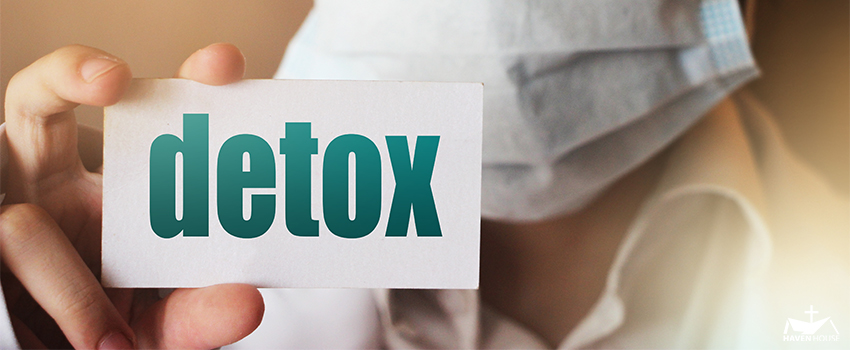
Recovering from drug addiction is not merely an issue of getting rid of the habit of ingesting drugs. A huge portion of addiction recovery is dealing with detox.
Simply put, drug detoxification pertains to the natural process of removing toxins and other harmful substances from the body. Drug addiction changes how the body, especially the brain, functions to accommodate the effects that a substance brings. This means that the amount of toxic substances present in the body can have a long-lasting effect and intensify drug withdrawal when not flushed out.
The Detoxification Process
Recovery centers follow specific procedures for a patient’s detoxification. These procedures are recommended by medical professionals and will help a recovery patient to detoxify and take a step towards full drug independence.
Sometimes people would ask what is the best way to detox your body. There is no specific “best” way when it comes to the process of cleansing the body of toxins. It always depends on a patient’s current health status.
1. Medical Assessment
The first step of cleansing for recovery is to find out which substances were used by a patient. This helps medical professionals identify the right treatment necessary for drug detox. Medical assessments provide precise information regarding a patient’s overall health and how much the abused substance changed the way his/her body functions.
Through medical assessments, the recovery center will have an idea on how to personalize a treatment on how to detox from drugs for a patient and help him/her undergo recovery.
2. Withdrawal Syndrome
When a patient officially begins the cleansing procedure, the first thing that he/she will experience is drug withdrawal. Also known fully as the withdrawal syndrome, it is a combination of physical and mental effects of abruptly stopping substance intake.
The withdrawal effects vary depending on the substances used and how severe a patient’s addiction to a said substance is. Common physical symptoms of withdrawal include headache, vomiting, fatigue, runny nose, and shakiness.
Meanwhile, psychological symptoms of withdrawal include depression, mood changes, insomnia, constant paranoia, cravings for the abused substance, and in worst cases, hallucinations.
3. Medication
Medical professionals recommend the appropriate medications for patients who are undergoing drug detox withdrawal. These medications are strictly controlled and should be administered by medical workers themselves.
Medications given to addiction recovery patients that experience withdrawal include insomnia and pain medications as well as the common medication for nausea and headache.
4. Support
During these tough times when a recovery patient experiences both physical and mental challenges, it is highly important that he/she will not feel like they are alone. Mental stress can push a patient to go back to his/her habit of substance abuse.
The personnel from a recovery center will monitor the recovery patients 24/7 and shower them with encouragement and support throughout the detoxification process. The staff and crew of recovery centers can give lessons to recovery patients on how to get clean from drugs.
The Drug Detoxification Period
There are numerous organizations in the United States that offer addiction recovery and teach people how to get clean from drugs. If you are undergoing drug addiction recovery, you will find out that the process of getting rid of toxins from your body differs from one person to another.
The average amount of time that a recovering addict spends for drug cleansing is a week. But, usually, the duration of the cleansing process depends on the severity of the addiction. In cases of multiple substance abuse, it is quite necessary to have a longer detox treatment.
1. Barbiturates
Recovery patients, who were heavily addicted to barbiturates and sleeping pills, will experience insomnia and anxiety in the first 24 hours of detoxification. These physical and mental types of withdrawal can go on for at least a couple of days. Medical personnel will have to keep a close eye on the patient at this point because this is a crucial point, where circulation problems may arise.
The withdrawal symptoms will peak in the first week depending on the severity of a patient’s addiction to barbiturates. There are cases where the appearance of withdrawal symptoms will be delayed and will not show up until after the first week. After the first week, the initial diagnosis may come back but in its worst form.
2. Opioids and Heroin
A common misconception is that anesthesia, which consists primarily of opioids, is highly addictive and that receiving anesthesia for any medical procedure can lead to addiction. Doctors and anesthesiologists explain that this is not the case.
According to Yale Medicine, the addiction cases that surround anesthesia happen because of the outdated practice of giving more pain medications than necessary.
If ever you experience getting addicted to anesthetics and want to know how to detox anesthesia from your body, you have to learn about the cleansing process that deals with opioids. The drug withdrawal symptoms for opioids depend on the potency of the substance that a patient has taken.
On the other hand, heroin withdrawal happens within hours. The withdrawal symptoms from both substances include teary eyes, anxiety, insomnia, muscle pain, and sweating. After a couple of days, these withdrawal symptoms will elevate and will now include diarrhea, nausea, abdominal cramps, blurry vision, and rapid heart rate.
In the span of a week, the withdrawal symptoms will slowly taper off. However, in cases of severe addiction, insomnia, depression, and anxiety will occur for at least six months.
3. Cocaine and Methamphetamine
Withdrawal from these two powerful stimulants includes a crash in the first few hours. This crash refers to body aches, fatigue, and mood changes that a patient undergoes in the hours that he/she stopped the drug intake.
Because cocaine and methamphetamine are strong stimulants, they can easily alter the brain’s hormonal activities. This is why in the span of a couple of days, recovery patients, who were addicted to stimulants, will show depressive and psychotic episodes. In the first week, expect a recovering patient to exhibit lethargy, erratic sleeping patterns, intense cravings for stimulants, depression, and poor concentration.
The cleansing process and withdrawal symptoms for cocaine and methamphetamine may go on for months before a patient fully recovers.
Strategies for Getting Rid of the Toxins in the Body
Drug detox is a difficult process for any patient. During this time, all types of support should be given to a patient to encourage him/her to welcome the positive changes that come from cleansing and rehabilitation.
If you are a recovery patient, and you finally decide that enough is enough and want to get rid of the toxic habit, here are drug detoxification strategies you can do and some tips on how to flush drugs out from your system.
1. Increase water intake.
Water does wonders for the body. During these tough times when withdrawal symptoms hit one after the other, it is best to drink more water. Drinking water can help flush out the toxins faster. Your body will also need replenishment when you suffer from diarrhea and vomiting.
Drinking a lot of water can also help patients who experience severe sweating and runny nose as a part of their withdrawal symptoms. It is highly recommended for recovery patients to drink at least 12 glasses of water per day. Cold water is also recommended if a recovery patient is experiencing fever-like body temperatures.
2. Be physically active.
Sweating can help in flushing out toxins. This is why the more physically active you get, the faster the cleansing process will be.
Low-intensity exercise can encourage the release of dopamine. Recovery patients are urged to go hiking, running, and even swimming, especially when cravings hit.
3. Practice meditations and breathing exercises.
Breathing stimulates the production of oxygen in the body. Breathing exercises and meditations can help in calming the body and the mind. They can help prevent a patient from giving in to cravings.
Meditation and breathing exercises also encourage better blood flow and, in some cases, sweating. They are highly beneficial in flushing out the toxins in the body. Meditation, in particular, provides several benefits in addiction recovery.
4. Stick with a nutritious diet plan.
If you are getting help from a recovery center, medical professionals will be the ones responsible for creating a diet plan that will aid your body throughout your journey to becoming addiction-free. While withdrawal symptoms can generally cause a decrease in appetite, you should still push yourself in sticking to the diet plan.
The diet plans are personalized according to your body’s needs during the process of cleansing, especially when you are in the worst part of having withdrawal symptoms. Following the recommended diet plan will enable your body to efficiently function once again.
5. Avoid triggers.
Withdrawal symptoms can take a toll on a person’s physical and mental health and cravings can be activated by the slightest triggers around you.
Among all drug detoxification strategies, avoiding triggers can be a more difficult feat. While on recovery, make sure to identify and to avoid situations or events that may trigger your cravings for substances.
If possible, avoid places where there are people who are keen on using drugs. Distract yourself with music or hobbies whenever the urge to seek substances occurs.
6. Lean on your support system.
If there is one important thing you should understand on your way to recovery, it is the fact that you are not alone in this journey. Friends and/or family will always be there with you through the toughest times. Despite your shortcomings, do understand that people, who truly love you, will want to see you succeed in your drug recovery.
Surround yourself with people who openly state their love and support for you. They will provide you with strength as you undergo the whole process of cleansing and recovery. It is not wrong to feel vulnerable, your friends and family will always be there to catch you at your lowest and encourage you to fight and live healthily once again.
7. Consult a professional.
Seeking professional help can be quite difficult. There will be instances wherein a patient may feel embarrassed and anxious, and these reasons stop him/her from checking into detox centers. Sometimes, even when people want to stop their drug consumption, they will still not seek medical help because they think they can detoxify themselves at home.
While home detox is possible, it is not advisable for people who have severe substance abuse. Rehabilitation centers are well-equipped with medical professionals who can monitor the health status of a patient, especially when he/she starts exhibiting withdrawal symptoms. A patient can also be confident that detox centers follow procedures on how to detox safely.
Certified recovery centers can help addiction patients regain their physical and mental health as well as gain the confidence to go back as a functioning member of society. Medical practitioners can also give post-recovery advice on how to get drugs out of your system.
Haven House Recovery Center Helps You With Cleansing and Rehabilitation
For men who need to undergo addiction recovery in Santa Rosa Beach, FL and are in need of a certified recovery center, Haven House Recovery Center can provide them with what they need.
HHRC adheres to the 12-step rehabilitation program that will help men learn how to detoxify and go back to their healthier self.
Call us now to get an idea of our rehabilitation services!
Newsletter Signup
Discipleship Training
“The teaching of the wise is a Fountain of Life, turning a person from the snares of death.”
Proverbs 13:14 NIV

